Ashton goes for fare boxes
Page 66
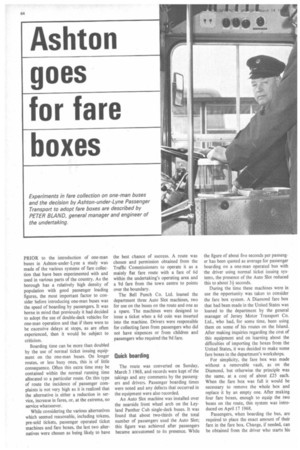
Page 67
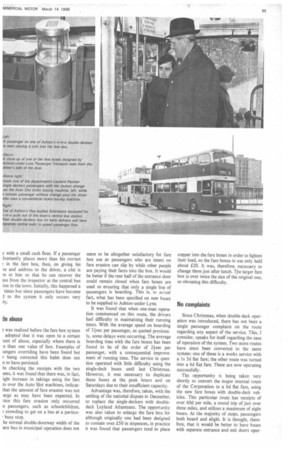
Page 68
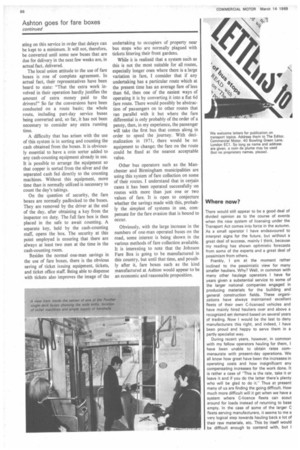
Page 69
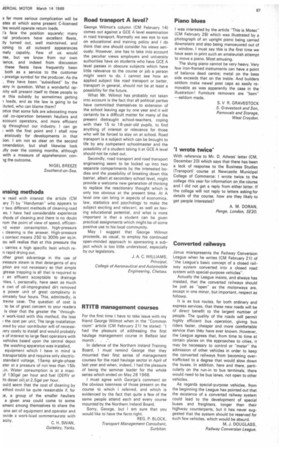
Page 70
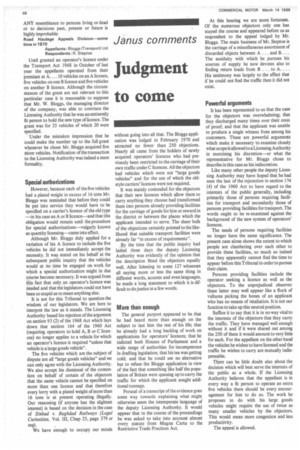
If you've noticed an error in this article please click here to report it so we can fix it.
PRIOR to the introduction of one-man buses in Ashton-under-Lyne a study was made of the various systems of fare collection that have been experimented with and used in various parts of the country. As the borough has a relatively high density of population with good passenger loading figures, the most important factor to consider before introducing one-man buses was the speed of boarding by passengers. It was borne in mind that previously it had decided to adopt the use of double-deck vehicles for one-man operation and that if there were to be excessive delays at stops, as are often experienced, then it would be subject to criticism.
Boarding time can be more than doubled by the use of normal ticket issuing equipment on the one-man buses. On longer routes, or less busy ones, this is of little consequence. Often this extra time may be contained within the normal running time allocated to a particular route. On this type of route the incidence of passenger complaints is not very high as it is realized that the alternative is either a reduction in service, increase in fares, or, at the extreme, no service whatsoever.
While considering the various alternatives which seemed reasonable, including tokens, pre-sold tickets, passenger operated ticket machines and fare boxes, the last two alternatives were chosen as being likely to have the best chance of success. A route was chosen and permission obtained from the Traffic Commissioners to operate it as a mainly flat fare route with a fare of 6d within the undertaking's operating area and a 9d fare from the town centre to points over the boundary.
The Bell Punch Co. Ltd. loaned the department three Auto Slot machines, two for use on the buses on the route and one as a spare. The machines were designed to issue a ticket when a 6d coin was inserted into the machine. Drivers were responsible for collecting fares from passengers who did not have sixpences or from children and passengers who required the 9d fare.
Quick boarding The route was converted on Sunday, March 3 1968, and records were kept of the takings and any comments by the passengers and drivers. Passenger boarding times were noted and any defects that occurred in the equipment were also recorded.
An Auto Slot machine was installed over the nearside front wheel arch on the Leyland Panther Cub single-deck buses. It was found that about two-thirds of the total number of passengers used the Auto Slot; this figure was achieved after passengers became accustomed to its presence. While the figure of about five seconds per passenger has been quoted as average for passenger boarding on a one-man operated bus with • the driver using normal ticket issuing systems, the presence of the Auto Slot reduced this to about 3-1 seconds.
During the time these machines were in use the opportunity was taken to consider the fare box system. A Diamond fare box that had been made in the United States was loaned to the department by the general manager of Jersey Motor Transport Co. Ltd., who had, for some time, been using them on some of his routes on the Island. After making inquiries regarding the cost of this equipment and on learning about the difficulties of importing the boxes from the United States, it was decided to make some fare boxes in the department's workshops.
For simplicity, the fare box was made without a removable vault, as on the Diamond, but otherwise the principle was the same, at a cost of about £.25 each. When the fare box was full it would be necessary to remove the whole box and replace it by an empty one. After making four fare boxes, enough to equip the two buses on the route, this system was introduced on April 17 1968.
Passengers, when boarding the bus, are required to place the exact amount of their fare in the fare box. Change, if needed, can be obtained from the driver who starts his y with a small cash float. If a passenger ivertently places more than his correct ; in the fare box, then, on giving his le and address to the driver, a chit is !..n to him so that he can recover the ess from the inspector at the central bus ion in the town. Initially, this happened a times but since passengers have become to the system it only occurs very t was realized before the fare box system adopted that it was open to a certain ,unt of abuse, especially where there is 'e than one value of fare. Examples of ;engers overriding have been found but r being corrected this habit does not n to have persisted.
)n checking the receipts with the two ems, it was found that there was, in fact, ight increase in takings using the fare es over the Auto Slot machines, indicatthat the amount of fare evasion was not arge as may have been expected. In lice this fare evasion only occurred n passengers, such as schoolchildren, crowding to get on a bus at a particu, busy stop.
he normal double-doorway width of the [ern bus in municipal operation does not seem to be altogether satisfactory for fare box use as passengers who are intent on fare evasion can slip by while other people are paying their fares into the box. It would be better if the rear half of the entrance door could remain closed when fare boxes are used so ensuring that only a single line of passengers is boarding. This is, in actual fact, what has been specified on new buses to be supplied to Ashton-under-Lyne.
It was found that when one-man operation commenced on this route, the drivers had difficulty in maintaining their running times. With the average speed on boarding of Ifsec per passenger, as quoted previously, some delays were occurring. The average boarding time with the fare boxes has been found to be of the order of 2+sec per passenger, with a consequential improvement of running time. The service in question operated with little difficulty using the single-deck buses until last Christmas. However, it was necessary to duplicate these buses at the peak hours and on Saturdays due to their insufficient capacity.
Advantage was, therefore, taken, with the settling of the national dispute in December, to replace the single-deckers with doubledeck Leyland Atlanteans. The opportunity was also taken to enlarge the fare box for although originally one had been designed to contain over £50 in sixpences, in practice it was found that passengers tend to place copper into the fare boxes in order to lighten their load, so the fare boxes in use only held about £20. It was, therefore, necessary to change them just after lunch. The larger fare box is over twice the size of the original one, so obviating this difficulty.
Since Christmas, when double-deck operation was introduced, there has not been a single passenger complaint on the route regarding any aspect of the service. This, I consider, speaks for itself regarding the ease of operation of the system. Two more routes have since been converted to the same system: one of these is a works service with a Is 3d flat fare; the other route was turned into a 6d flat fare. These are now operating successfully.
The opportunity is being taken very shortly to convert the major internal route of the Corporation to a 6d flat fare, using the new fare boxes with double-deck vehicles. This particular route has receipts of over 60d per mile, a round trip of just over three miles, and utilizes a maximum of eight buses. At the majority of stops, passengers both board and alight. It is thought, therefore, that it would be better to have buses with separate entrance and exit doors oper ating on this service in order that delays can be kept to a minimum. It will not, therefore, be converted until some new buses that are due for delivery in the next few weeks are, in actual fact, delivered.
The local union attitude to the use of fare boxes is one of complete agreement. In actual fact, their representatives have been heard to state: "That the extra work involved in their operation hardly justifies the amount of extra money paid to the drivers!" So far the conversions have been conducted on a route basis; the whole route, including part-day service buses being converted and, so far, it has not been necessary to consider any extra running time.
A difficulty that has arisen with the use of this system is in sorting and counting the cash obtained from the boxes. It is obviously essential to have a coin sorter added to any cash-counting equipment already in use. It is possible to arrange the equipment so that copper is sorted from the silver and the separated cash fed directly to the counting machines. Without this equipment. more time than is normally utilized is necessary to count the day's takings.
On the question of security, the fare boxes are normally padlocked to the buses. They are removed by the driver at the end of the day, after obtaining a key from the inspector on duty. The full fare box is then placed in the safe to await counting. A separate key, held by the cash-counting staff, opens the box. The security at this point employed is ensuring that there are always at least two men at the time in the cash-counting room.
Besides the normal one-man savings in the use of fare boxes, there is the obvious saving of ticket issuing equipment, tickets, and ticket office staff. Being able to dispense with tickets also improves the image of the undertaking to occupiers of property near bus stops who are normally plagued with tickets littering their front gardens.
While it is realize;d that a system such as this is not the most suitable for all routes, especially longer ones where there is a large variation in fare, I consider that if any undertaking has a particular route which at the present time has an average fare of less than 6d, then one of the easiest ways of operating it is by converting it into a flat 6d fare route. There would possibly be abstraction of passengers on to other routes that ran parallel with it but where the fare differential is only probably of the order of a penny, then, in my experience, the passenger will take the first bus that comes along in order to speed the journey. With decimalization in 1971, there would be no equipment to change: the fare on the route could be fixed at the nearest acceptable value.
Other bus operators such as the Manchester and Birmingham municipalities are using this system of fare collection on some of their routes. I understand that in certain cases it has been operated successfully on routes with more than just one or two values of fare. It is open to conjecture whether the savings made with this, probably the simplest of systems in use, compensate for the fare evasion that is bound to occur.
Obviously, with the large increase in the numbers of one-man operated buses on the road, some interest is being shown in the various methods of fare collection available. It is interesting to note that the Johnson Fare Box is going to be manufactured in this country, but until that time, and possibly after it, fare boxes such as the kind manufactured at Ashton would appear to be an economic and reasonable proposition.
There would still appear to be a good deal of divided opinion as to the course of events when the new system of licensing under the Transport Act comes into force in the autumn. As a small operator I have endeavoured to interpret signs for the future, but without a great deal of success, mainly I think, because my reading has shown optimistic forecasts from some of the experts and a great deal of pessimism from others.
Frankly, I am at the moment rather inclined to the pessimistic view for many smaller hauliers. Why? Well, in common with many other haulage operators I have for years given a substantial service to some of the larger national companies engaged in producing materials for the building and general construction fields. These organizations have always maintained excellent fleets of their own C-licensed vehicles and have mainly hired hauliers over and above a recognized set demand based on several years of trading. Now I would be the last to deny manufacturers this right, and indeed, I have been proud and happy to serve them in a partly specialist way.
During recent years, however, in common with my fellow operators hauling for them, I have been unable to obtain rates commensurate with present-day operations. We all know how great have been the increases in operating costs and how insignificant any compensating increases for the work done. It is rather a case of "This is the rate, take it or leave it and if you do the latter there's plenty who will be glad to do it." Thus at present many of us are finding the going difficult. How much more difficult will it get when we have a system where C-licence fleets can scout around for loads instead of returning to base empty. In the case of some of the larger C fleets serving manufacturers, it seems to me a very logical step towards hauling back a lot of their raw materials, etc. This by itself would be difficult enough to contend with, but I a far more serious complication will be ates at which some present C-licensed les would operate return loads.
face the position squarely: many producers have excellent fleets, tly turned out, well maintained, and ioning to all outward appearances rnely capably. Few of us would ree, but we know from our own ience, and indeed from discussion these fleets have frequently been both as a service to the customer prestige symbol for the producer. As the , they have been "subsidized" by the 'any in question. What a wonderful opnity will present itself to these people to :e this subsidy by sometimes getting 1 loads, and as the law is going to be ituted, who can blame them?
once that some folk are advocating more cal co-operation between hauliers and account operators, and more efficient ig throughout our industry. I can go I with the first point and I shall now anxiously for developments in that :ion. I am not so clear on the second nmendation, but shall likewise look .illy over the coming months, although with a measure of apprehension conrig the outcome.
NIGEL BREEZE Southend-on-Sea.
msing methods 'e read with interest the article (CM ary 7) by "Handyman" who appears to r two different methods of cleaning road es. I have had considerable experience thods of cleaning and there is no doubt rom the point of view of speed, efficien-id water consumption, high-pressure cleaning is the answer. High pressure ; context means 250 to 300Ih per sq.in. ou will realize that at this pressure the carries a high specific heat which ren rapid drying out.
ither great advantage in the use of iressure steam is that detergents of any ption are not necessary so that simple grease trapping is all that is required to a an effluent acceptable to drainage rities. I, personally, have seen as much e cwt of oil-impregnated dirt removed a power unit of great complexity in ould seem that the cost of cleaning by ethod could be quite reasonable if, for 3e, a group of the smaller hauliers a given area could come to some ament among themselves to share the one set of equipment and operator and ovide a work-load commensurate with acity. C. H. SWAN, Guiseley, Yorks. Road transport A level? George Wilmot's column (CM February 14) comes out against a GCE A level examination in road transport. Normally we see eye to eye on educational and training policy and I do think that one should consider his views seriously. However, one has to take into account the peculiar views employers and university authorities have on students who have GCE A level passes in obscure subjects which have little relevance to the course or job a person might want to do. I cannot see how an applied subject like road transport or better, transport in general, should not be at least a possibility for the future. What Mr. Wilmot has probably not taken into account is the fact that all political parties have committed themselves to extension of the school leaving age by one year and it will certainly be a difficult matter for many of the present distraught school-teachers, coping with their 15 to 16-year-old pupils, to find anything of interest or relevance for those who will be forced to stay on at school. Road transport is a subject which can be brought to life by any competent schoolmaster and the possibility of a student taking it at GCE A level should not be ruled out. Secondly, road transport and road transport engineering seem to be locked up into two separate compartments by the interested bodies and the possibility of breaking down this barrier, albeit at secondary school level, might provide a welcome new generation of thinking to replace the reactionary thought which is only too obvious at the present time. At A level one can bring in aspects of economics, law, statistics and psychology to make the subject exciting and relevant, as well as having educational potential, and what is more important is that a student can be given practical assignments which might be of some positive use to his local community. May I suggest that George Wilmot proceeds, as usual, to employ his continued open-minded approach to sponsoring a subject which is too little understood, especially by our legislators. J. A. C. WILLIAMS, Principal, College of Aeronautical and Automobile Engineering, Chelsea. RTITB management courses For the first time I have to take issue with my friend George Wilmot when in the "Common room" article (CM February 21) he stated: "I had the pleasure of addressing the first haulage management course in Belfast last month .". In defence of the Northern Ireland Training Board, I must remind George that they mounted their first series of management courses for the road haulage sector in April of last year and when, indeed, I had the pleasure of being the seminar leader for the whole series which ended on May 28 1968. I must agree with George's comment on the obvious keenness of those present on the course to which I referred, and which is evidenced by the fact that quite a few of the same people attend each and every course mounted by the Northern Ireland Board, Sorry, George, but I am sure that you would like to have the facts right. REG. P. BLOCK, Transport Management Consultant, Surbiton. I was interested by the article -This is Motec" (CM February 28) which was illustrated by a photograph of an upright piano being carried downstairs and also being manoeuvred out of a window. I must say this is the first time we have seen in print such an amateurish attempt to move a piano. Most amusing. The slung piano cannot be very heavy. Very few iron-framed instruments can have a ipoint of balance dead centre; metal on the bass side exceeds that on the treble. And builders seldom make newel post caps so easily removable as was apparently the case in the illustration! Furniture removers are "born" —seldom made. S. V R. GRAVESTOCK S. Gravestock and Son, Removals and Storage, West Croydon. 'I wrote twice' With reference to Mr. D. Adwas' letter (CM. December 20) which says that there has been a lack of response to the Business Studies (Transport) course at Newcastle Municipal College of Commerce: I wrote twice to the college this year for information on the course and I did not get a reply from either letter. If the college will not reply to letters asking for details of the course, how are they likely to get people interested? A. M. DORAN, Penge, London, SE20. Converted railways Janus misrepresents the Railway Conversion League when he writes (CM February 21) of -the League's basic concept of a closed railway system converted into a closed road system with special-purpose vehicles". Actually the League insists, and always has insisted, that the converted railways should be just as "open" as the motorways are, except in one minor, but important, respect as follows. It is as bus routes, for both ordinary and express services, that these new roads will be of direct benefit to the largest number of people. The quality of the roads will permit highly efficient bus operation, giving bus riders faster, cheaper and more comfortable service than they have ever known. However, the League agrees that, from time to time at certain places on the approaches to cities, it may be necessary to control or "meter" the admission of other vehicles in order to keep the converted railways from becoming overtrafficked to a degree that would slow down the buses. In addition, here and there, particularly on the run-in to bus terminals, there would need to be bus lanes, not open to other vehicles. As regards special-purpose vehicles, from the beginning the League has pointed out that the existence of a converted railway system could lead to the development of special buses and freighters, longer than their highway counterparts, but it has never suggested that the system should be reserved for such few vehicles, which would be absurd. M. J. DOUGLASS, Railway Conversion League. ANY resemblance to persons living or dead or to decisions past, present or future is highly improbable: Road Haulage Appeals Division—some time in 1970 Appellants: Bloggs (Transport) Ltd Respondents: H. Steptoe Until granted an operator's licence under the Transport Act 1968 in October of last year the appellants operated from their premises at A.... 10 vehicles on an A licence, five vehicles on one B licence and five vehicles on another B licence. Although the circumstances of the grant are not relevant to this particular case it is reasonable to suppose that Mr. W. Bloggs, the managing director of the company, was able to convince the Licensing Authority that he was an eminently fit person to hold the new type of licence. The grant was for 25 vehicles of which 20 were specified. Under the mistaken impression that he could make the number up to the full grant whenever he chose Mr. Bloggs acquired five more vehicles. Notification of the transaction to the Licensing Authority was indeed a mere formality.Tags




















































































































